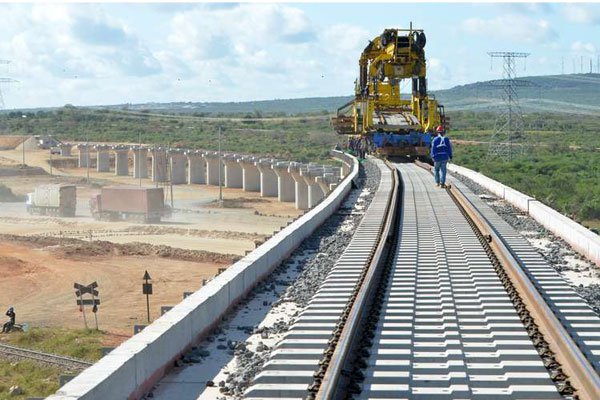Share this
China Road and Bridge Corporation employee at work on the standard gauge railway. PHOTO | FILE | NATION MEDIA GROUP
Lessons from Asian tigers that you won’t hear from political leaders
In Summary
- Even good economists are not immune from misunderstanding economics.
- The economy is growing at five-and-a-half per cent per year, which, we are told, is quite good.
- It is a matter of public record that export-led industrialisation was the engine of East Asian Tigers’ economic takeoff.
- A garment factory in Naivasha has to transport the fabric and finished product 1,200 kilometres back and forth from Mombasa.
I was recently called by a reporter to comment on an article he was writing on the findings of a study by a group of Japanese economists faulting “our economic model” (Japan scholars punch holes in Kenya’s growth model” Business Daily, July 25).
I have not seen the study, but the gist of it is captured by the statement attributed to one of the lead authors to the effect that our economic growth “has not been broadly based in terms of poverty reduction through employment creation.” The study reportedly also flags weakening of our manufacturing sector and stagnation of agricultural productivity.
You can imagine my bemusement as I listened to the reporter explaining to me what he seemed to think were novel earth-shaking revelations, but which, as I demonstrated to him in considerable detail, are the very things that I have been speaking and writing about week in week out for as long as I can remember.
The young reporter is not alone. One of the lessons I have learned from decades of explaining economic ideas is that complex things can look deceptively simple — misleading many people to think they have understood concepts that they actually haven’t. In economics, the obvious is never simple, and as we will see shortly, it is often counter-intuitive.
Take economic growth. The economy is growing at five-and-a-half per cent per year, which, we are told, is quite good. What’s good about it? Why not 20 per cent?
When economists debate economic growth, we are not talking about the economy expanding by three, five or eight per cent from year to year — the weather alone is sufficient to cause these fluctuations. What we really talk about is productivity.
In 1965, a South Korean worker was on average 20 per cent more productive than a Kenyan one. Today, they are 15 times more productive. That is economic growth. What causes it?
Think about the economy as a warehouse in which goods are loaded and offloaded. One worker unpacking and moving boxes alone can offload 10 boxes an hour. With two workers, one unpacking and the other moving the boxes, they can do 25 boxes an hour, and five workers passing the boxes in a chain can do 100 boxes.
The hourly productivity of one worker alone is 10 boxes, two workers raises it to 12.5 boxes per worker and a gang of five workers raises it to 20 boxes per worker.
Many hands make light work. That is one source of economic growth.
WHEELBARROW COSTS SH5,000
A worker with a wheelbarrow can offload 100 boxes per hour. One worker with a forklift offloads 10 times as much, that is, 1,000 boxes an hour. Should an economy without capital invest in wheelbarrows or forklifts?
A wheelbarrow costs Sh5,000 (except in Bungoma). A forklift costs a million. One forklift buys 200 wheelbarrows. Two hundred wheelbarrows will move 10,000 boxes an hour. The forklift raises the productivity of one worker to 1,000 boxes per hour, but the other 199 workers who would have used wheelbarrows to raise their productivity remain at the maximum manual productivity of 20 boxes per hour, for a total output of 4,980 boxes, translating to productivity of 24.9 boxes per worker, a quarter of the labour productivity of the wheelbarrow economy.
My critique of our economic model, which the Japanese scholars echo, has often been misconstrued as “left wing” income distribution arguments. This illustration hopefully clarifies that what I have argued for many years is about allocation of capital, not redistribution of income, about inequitable distribution of tools, not of food.
Case in point is my good friend, Prof J. Kieyah, who was quoted as saying: “To reduce poverty is to increase growth no matter where that growth is coming from. We are baking the cake now and making it bigger. We cannot start talking of division before we grow enough.”
To reduce poverty, it does matter where growth is coming from. Even good economists are not immune from misunderstanding economics.
Challenged on the viability of the standard gauge railway at his Infrastructure Summit the other day, President Kenyatta unleashed another one of his trademark tantrums.
When reference was made to analysis by the World Bank, he reportedly dismissed it offhand, asserting that East Asian Tigers had developed by defying the advice of the Bretton Woods institutions. This was yet another one of those occasions where an even temperament would have served him well. As I have said before, no amount of growling at critics is going to make foolish investments wise.
It is a matter of public record that export-led industrialisation was the engine of East Asian Tigers’ economic takeoff. We also know that “low-tech” labour intensive industries, garments and electronics assembly in particular— “sweatshop manufacturing” as its called — provided the initial industrialisation impetus. This knowledge already tells us a lot about the character of East Asia’s capital formation that drove the takeoff.
How much capital is required to create a garment manufacturing job? A sewing machine costs no more than $1,000. You will, of course, need a building, but not a particularly sophisticated one. A school classroom will sit 20 workers comfortably. Make that another $500 per worker. A few other things and you are talking no more than $2,000 per worker.
I am told that a swanky new shopping mall and commercial complex coming up in my neighbourhood is a $200 million investment. That would have financed 100,000 sweatshop jobs.
In Bangladesh, each garment stitching job generates $6,000 per year in export earnings. Eighty per cent of the workers are women, the majority of them from disadvantaged backgrounds. A hundred thousand jobs works out to $600 million worth of export earnings. If we are pouring our capital into concrete to merchandise fashion instead of equipping our underutilised workers to be more productive, it should not surprise us that our productivity has stagnated.
Private investors are free to put their capital where they will. The State is not. The SGR’s $4 billion outlay in sweatshops would have created two million jobs.
The latest brainwave in the Jubilee administration is to extend the line to Naivasha and locate an industrial park with a view to attracting textile industries to utilise cheap geothermal power and steam. It does not make business or economic sense.
The most sensible location for export-oriented industries is near port cities. This minimises transport and logistics costs, including turnaround time. A garment factory in Naivasha has to transport the fabric and finished product 1,200 kilometres back and forth from Mombasa. At the break-even tariff for the standard gauge railway, given as $0.08 per tonne per kilometre, this translates to an additional unnecessary transportation cost of $96 per tonne, which works out to $0.06 per pair of jeans for example.
INFRASTRUCTURE INVESTMENTS
Even if power and steam were given free, it would not be sufficient to offset this cost.
One of the alternative infrastructure investments that I suggest when challenged by the SGR faithful is a major highway and commuter rail along the coastline (Malindi to Diani) and from Mombasa to Voi. A 10-kilometre-wide urban belt clustered along the 300-kilometre corridor has the potential of a 10 million people metropolis.
A sensible political leadership would have realised a long time ago that the coast is the place to concentrate infrastructure to industrialise Kenya. Why does this and other such sensibilities continue to elude them?
In an op-ed published in the Business Daily, Keiko Sano, the Jica country office chief, singles out an “inclusive political order” as the fundamental that underlies the success of the Asian Tigers’ industrial policy.
What she means is political leadership that chooses to pursue the prosperity and wellbeing of society as a whole. In economic sphere it translates to what is now referred to as inclusive growth, which the OECD defines as “growth that creates opportunity for all segments of the populace” and which “distributes the dividends of increased prosperity fairly across society”. In short, it is a growth strategy centred on employment and equity.
When he retired as Singapore’s Prime Minister, Lee Kwan Yew had little more to his name than his home and a pension. Singapore was the first developing country to provide decent housing for all its citizens. I do not know of any of the famed leaders of the East Asian countries who rank among the wealthiest people in their countries.
The primary preoccupation of the oligarchy that has ruled this country from independence is and will probably forever remain its own prosperity, not that of society as a whole. After independence, its preoccupation was not how to get every worker a wheelbarrow, but how to acquire the mzungu’s forklifts for themselves. They cannot visualise the coast’s industrial potential because they are blinded by beach plots.
Once they became owners of capital they acquired vested interest in policies and public investments that maximise returns to capital, which more often than not undermine productivity and competitiveness. There is no business owner who likes competition. They shout from the rooftops about attracting foreign investment but the only foreign investment they will permit is that which will not compete with their businesses, and joint ventures with themselves.
The “mechanics” of East Asia’s economic transformation are now well-documented and understood. What remains a mystery is the political software — why their political elites chose to enrich their societies, as opposed to themselves.
And that, of course, is not a lesson from the Asian Tigers that you are ever going to hear about from our political elite, President Kenyatta included.




















